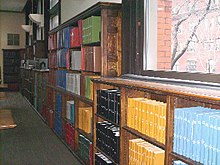
A book is a medium for recording information in the form of writing or images, typically composed of many pages bound together and protected by a cover. It can also be a handwritten or printed work of fiction or nonfiction, usually on sheets of paper fastened or bound together within covers. The technical term for this physical arrangement is codex. In the history of hand-held physical supports for extended written compositions or records, the codex replaces its predecessor, the scroll. A single sheet in a codex is a leaf and each side of a leaf is a page.

Buckram is a stiff cotton cloth with a plain, usually loose, weave, produced in various weights similar to muslin and other plain weave fabrics. For buckram, the fabric is soaked in a sizing agent such as wheat-starch paste, glue, or pyroxylin, then dried. When rewetted or warmed, it can be shaped to create durable firm fabric for book covers, hats, and elements of clothing.

A hardcover, hard cover, or hardback book is one bound with rigid protective covers. It has a flexible, sewn spine which allows the book to lie flat on a surface when opened. Modern hardcovers may have the pages glued onto the spine in much the same way as paperbacks. Following the ISBN sequence numbers, books of this type may be identified by the abbreviation Hbk.

The Harvard Classics, originally marketed as Dr. Eliot's Five-Foot Shelf of Books, is a 50-volume series of classic works of world literature, important speeches, and historical documents compiled and edited by Harvard University President Charles W. Eliot. Eliot believed that a careful reading of the series and following the eleven reading plans included in Volume 50 would offer a reader, in the comfort of the home, the benefits of a liberal education, entertainment and counsel of history's greatest creative minds. The initial success of The Harvard Classics was due, in part, to the branding offered by Eliot and Harvard University. Buyers of these sets were apparently attracted to Eliot's claims. The General Index contains upwards of 76,000 subject references.
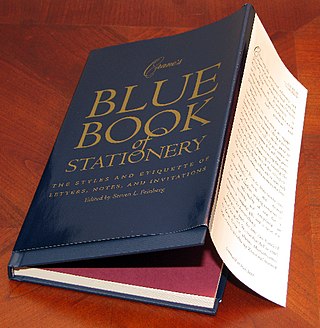
The dust jacket of a book is the detachable outer cover, usually made of paper and printed with text and illustrations. This outer cover has folded flaps that hold it to the front and back book covers.

Bookworm is a general name for any insect that is said to bore through books.

Traditional Chinese bookbinding, also called stitched binding, is the method of bookbinding that the Chinese, Koreans, Japanese, and Vietnamese used before adopting the modern codex form.
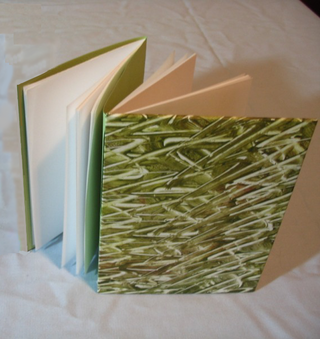
In bookbinding, a dos-à-dos binding is a binding structure in which two separate books are bound together such that the fore edge of one is adjacent to the spine of the other, with a shared lower board between them serving as the back cover of both. When shelved, the spine of the book to the right faces outward, while the spine of the book to the left faces the back of the shelf; the text of both works runs head-to-tail.

Bindery refers to a studio, workshop or factory where sheets of (usually) paper are fastened together to make books, but also where gold and other decorative elements are added to the exterior of books, where boxes or slipcases for books are made and where the restoration of books is carried out.
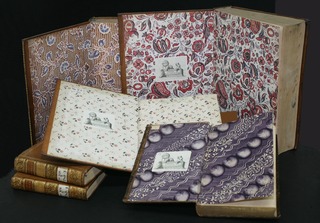
The endpapers or end-papers of a book are the pages that consist of a double-size sheet folded, with one half pasted against an inside cover, and the other serving as the first free page. Thus, the front endpapers precede the title page and the text, whereas the back endpapers follow the text. Booksellers sometimes refer to the front endpaper as FEP.
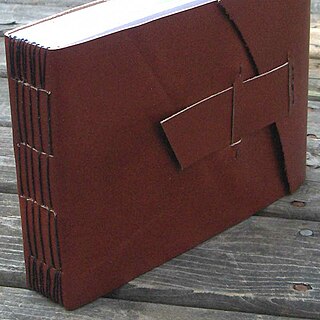
In the art of bookbinding, the longstitch technique is used for binding the sections (signatures) of a book without using glue. In Non-adhesive Binding: Books without Paste of Glue (1999) Keith A. Smith describes that binding a book with a "longstitch through a slotted cover" involves directly sewing each section through the cover, which has slots for attaching each section, and creates a pattern of staggered lines that is visible on the spine of the book.
Oversewn bindings are a type of bookbinding produced by sewing together loose leaves of paper to form a text block. Threads pass through small holes that have been punched in the signature's gutter margin, forming overlock stitches that attach it to previously attached sections. This method of stitching is sometimes called stab sewing. A piece of linen is then glued to the text block spine for further support. The book's spine may be rounded and backed to keep it from caving in, but if the text block is too thick, the spine is sometimes left flat. A strip of cloth called a super is then often affixed to the spine of the text block and then to the boards of the case. Oversewing can be done by hand but is usually done with a machine in a bindery.

Bookbinding is the process of building a book of codex manuscripts from an ordered stack of paper sheets with one's hands and tools. Firstly, one binds the sheets of papers along an edge with a thick needle and strong thread. One can also use loose-leaf rings, binding posts, twin-loop spine coils, plastic spiral coils, and plastic spine combs, but they last for a shorter time. Next, one encloses the bound stack of paper in a cover. Finally, one places an attractive cover onto the boards, and features the publisher's information and artistic decorations.

The Homer D. Babbidge Library (HBL) is the main library on the University of Connecticut campus in Storrs.

Book rebinding is the renewal or replacement of the cover of a book. Typically, this requires restitching or renewal of the glue which holds the pages in place.
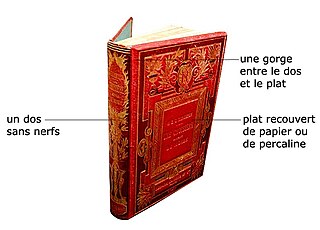
A Bradel binding is a style of book binding with a hollow back. It most resembles a case binding in that it has a hollow back and visible joint, but unlike a case binding, it is built up on the book. Characteristic of the binding is that the material covering the outside boards is separate from that covering the spine. Many bookbinders consider the Bradel binding to be stronger than the Case binding.
The Reprint Society, trading as World Books, was a book club in the United Kingdom founded by Alan Bott in 1939 who also started the Book Society, the Avalon Press and Pan Books. The club dominated the middle brow sector of the book club business in the U.K. until it was sold in 1966.

The conservation and restoration of books, manuscripts, documents, and ephemera is an activity dedicated to extending the life of items of historical and personal value made primarily from paper, parchment, and leather. When applied to cultural heritage, conservation activities are generally undertaken by a conservator. The primary goal of conservation is to extend the lifespan of the object as well as maintaining its integrity by keeping all additions reversible. Conservation of books and paper involves techniques of bookbinding, restoration, paper chemistry, and other material technologies including preservation and archival techniques.

George A. Baer was a German/Swiss/American bookbinder. He specialized in fine leather bindings, including inlays and gold tooling.

Janice Elaine Merrill-Oldham was an American librarian and conservator who was a preeminent figure in the field of library binding and conservation. She served as Malloy-Rabinowitz Preservation Librarian and director of the Weissman Preservation Center at the Harvard Library from 1995 to 2010. She founded and led the University of Connecticut Libraries' Preservation Department from 1983 to 1995.


